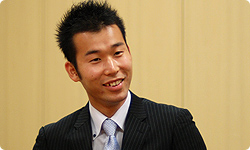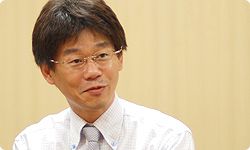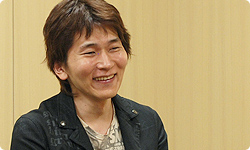6. Experiencing 60 Frames per Second
Lastly, I’d like each of you to talk about something you feel is a favourable aspect of the game. Let’s start with Matsushita-san.
This time I learned how hard it is to make a sequel. Especially since the original game was so highly rated. For that reason, we developed the game with fans of the original in mind, particularly during the latter half of development. I would love to hear the reaction from fans of Sin and Punishment.
You’re looking forward to it, but…
I’m also a little afraid. (laughs)
Is it a good fear?
You might say that. (laughs)

All right, next is Hattori-san.
Earlier, the guys from Treasure said that everyone on the team made the game however they liked. I think that is reflected in the contents of the game, because you can play Sin and Punishment: Successor of the Skies however you like. The system follows one route, but you can choose whichever controller you like best. There is no predetermined way to achieve a high score.
The game doesn’t have a right answer.
That’s right. You might think that using a certain controller on a particular screen will get you a high score, or that since you’re getting different scores in the air than you are fighting on land that you should try something else, or that you’ll get better scores by taking out the enemy in a particular order. It’s an incredibly interesting game for exploring various strategies. I’d like players to work together in finding the right way for them. When you check the ranking, you may find that people using a certain controller are getting higher scores. It’s a game that inspires friendly competition over ranking, too, so I hope players will also enjoy that.

You can play this game with Nintendo Wi-Fi Connection, right?
Yes. You can see the rankings for the whole country there. Editor’s note: In the European release of the game players can see the ranking of players in Europe and the US.
Okay, Yamagami-san?
Some people who learn about this game from this session of “Iwata Asks” might think it’s not a game for them since we got a little core about it sometimes, but I don’t want them to think that.
Because you made it so anyone can enjoy it.
Right. Among those of us who worked on the game, I’m the worst at playing it. I lose all the time. But even if you are beaten, there’s no need to start over from the beginning. You can easily progress from stage to stage, so those who just want to experience the world of Sin and Punishment can fully enjoy it.
The world of Sin and Punishment has always been grand in scale.
That’s right. Part of this incredible, epic, profound and mysterious world is recreated within the game this time, and Nintendo’s website for the game introduces it from that angle. I hope even players who aren’t that great at shooting games will enjoy this game world.

Maegawa-san, if you would, please.
We originally had hardcore fans in mind, and I think we succeeded in making a game that they can enjoy. As Yamagami-san just mentioned, however, the easy mode serves as an introduction to shooting games, so I’d like to say to people who have never played this kind of game that its old-fashioned style of dodging, shooting and competing for top scores can be really fun. We talked about making the game however we liked, and I think that’s because this type of game is so enjoyable.
Shooting games were once mainstream.
That’s right. Dodging, shooting, comparing scores - playing on the edge of your seat - is fun for people everywhere. I think the fun crosses borders. What’s more, this time we made it at a frame rate13 of 60 frames. 13Frame rate: The number of times the image on the screen is refreshed per second. Most games run at 30 frames per second. Sixty is particularly suitable for fighting and racing games.
Why did you decide on that?
Just about the time development of Sin and Punishment began, Mario Galaxy14 came out. When I heard it was being made at 60 frames per second, I thought we should do the same thing. 14Super Mario Galaxy: A 3D platform game released for the Wii console in Europe in November 2007.
(laughs)
So we really worked hard and made it 60 frames per second. When you play it, the difference is obvious. The movement is so much smoother.

It is clearly different when you play it.
But you can’t tell the difference with screenshots.
And even if you show videos on the Internet, they don’t run at 60 frames per second. For example, we could have everyone watch videos on the Nintendo Channel15, but unfortunately they wouldn’t show at 60 frames per second. 15Nintendo Channel: Users can see information related to Wii and Nintendo DS here, and download DS demos. It can be viewed from the Wii Menu. For information on the Nintendo Channel, click here.
That’s why we’re having a demo version available in select stores.16 I hope everyone will go try out the game. 16Select stores: The demo version of Sin and Punishment: Successor of the Skies was playable at participating retailers during the Japanese release.
Nakagawa-san?
Let’s see, um…I’ll finish up from my angle as a programmer. Given the hardware performance, we have done something pretty sophisticated, almost impossible, and the contents, as usual, are a real jumble. We really outdid ourselves, so, uh…

So…?
So please check it out!
(laughs) That leaves you, Suzuki-san.
I’ll represent the designers. This time we had more volume to work with, so we packed in as much as we could. We focused heavily on having all kinds of opponents and movement in the vast background. You can play many times and always discover something new.
Suzuki makes an astounding amount of materials, which really kept everyone on their toes! (laughs) The opponents are innumerable!
It’s almost unthinkable with a team of this scale. This volume, with just this many people…
Earlier we talked about making it feel like the original, but I assembled it from the start as a new game. I think I could do that without restraint because I designed the original.
Some people are saying it’s much brighter.
I always want to make something new, so I added increased colour, and brightened it up.

You want players to enjoy differences like that.
Yes.
I guess I’m last. As games grow with the times to be larger in scale, teams operate more systematically, specialisation increases, and the sphere of each person’s work narrows. Maegawa-san’s approach could be said to place an incredible burden on each individual when making a modern large-scale product. Nonetheless, you say, “We don’t have someone dedicated specifically to planning. The individuals who draw and program do the planning.” You consistently implement that approach, and make some solid products. This time in “Iwata Asks,” I ended up hearing things entirely different than I had imagined beforehand, and truly found them interesting. I sincerely hope we are able to convey to as many people as possible the great amount of passion and energy that you have put into this game. You’re not the type to brag, so I hope players will experience through the game your energy and the enthusiasm you have poured into it. Thank you for your time today.

Thank you for inviting us.
By the way, Maegawa-san.
Yes?
I’ve dealt with a lot of teams with different personality compositions…but Treasure’s is certainly unique. (laughs)
(laughs)
Of course, I mean that in a good way.
Well, thank you! (laughs)
